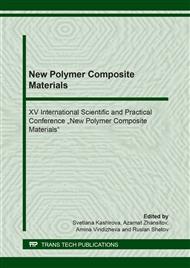[1]
Lee H., Neville K., Handbook of epoxy resins. (1967).
Google Scholar
[2]
Raquez J. M. et al. Thermosetting (bio) materials derived from renewable resources: a critical review, Progress in polymer science 35 (2010) 487-509.
DOI: 10.1016/j.progpolymsci.2010.01.001
Google Scholar
[3]
Boyle M. A. et al. Epoxy resins, ASM handbook, 21 (2001) 78-89.
Google Scholar
[4]
Jin F. L., Li X., Park S. J. Synthesis and application of epoxy resins: A review, Journal of Industrial and Engineering Chemistry. 29 (2015) 1-11.
Google Scholar
[5]
.ASTM International D638-10 // Standard Test Method for Tensile Properties of Plastics.
Google Scholar
[6]
ASTM International D3039/ D3039M-00 // Standard Test Method for Tensile Properties of Polymer Matrix Composite Materials.
Google Scholar
[7]
Czub P., Synthesis of high‐molecular‐weight epoxy resins from modified natural oils and Bisphenol A or BisphenolA‐based epoxy resins, Polymers for Advanced Technologies. 20 (2009) 194-208.
DOI: 10.1002/pat.1252
Google Scholar
[8]
Wu C. C., Lee W. J. Synthesis and properties of copolymer epoxy resins prepared from copolymerization of bisphenol A, epichlorohydrin, and liquefied Dendrocalamus latiflorus, Journal of applied polymer science. 116 (2010) 2065-2073.
DOI: 10.1002/app.31703
Google Scholar
[9]
Kwak G. H., Park S. J., Lee J. R. Thermal stability and mechanical behavior of cycloaliphatic–DGEBA epoxy blend system initiated by cationic latent catalyst, Journal of applied polymer science. 78 (2000) 290-297.
DOI: 10.1002/1097-4628(20001010)78:2<290::aid-app80>3.0.co;2-9
Google Scholar
[10]
Dias Filho N. L. et al. Relationship between the dielectric and mechanical properties and the ratio of epoxy resin to hardener of the hybrid thermosetting polymers, Journal of the Brazilian Chemical Society. 17 (2006) 533-541.
DOI: 10.1590/s0103-50532006000300016
Google Scholar
[11]
Ladaniuc M. A. et al. Study on the Reactants Molar Ratio Influence on the Properties of Standard Epoxy Resin/Glycols-Modified Epoxy Resin Compounds, MATERIALE PLASTICE.52 (2015) 433-436.
Google Scholar
[12]
Aouf C. et al. Multi-functionalization of gallic acid. Synthesis of a novel bio-based epoxy resin, European Polymer Journal. 49 (2013) 1185-1195.
DOI: 10.1016/j.eurpolymj.2012.11.025
Google Scholar
[13]
Chang T. D., Carr S. H., Brittain J. O. Studies of epoxy resin systems: Part B: Effect of crosslinking on the physical properties of an epoxy resin, Polymer Engineering & Science. 22 (1982) 1213-1220.
DOI: 10.1002/pen.760221807
Google Scholar
[14]
Meyer F. et al. The effect of stoichiometry and thermal history during cure on structure and properties of epoxy networks, Polymer.36 (1995) 1407-1414.
DOI: 10.1016/0032-3861(95)95918-q
Google Scholar
[15]
Choy I. C., Plazek D. J. The physical properties of bisphenol A based epoxy resins during and after curing, Journal of Polymer Science Part B: Polymer Physics. 24 (1986) 1303-1320.
DOI: 10.1002/polb.1986.090240609
Google Scholar


